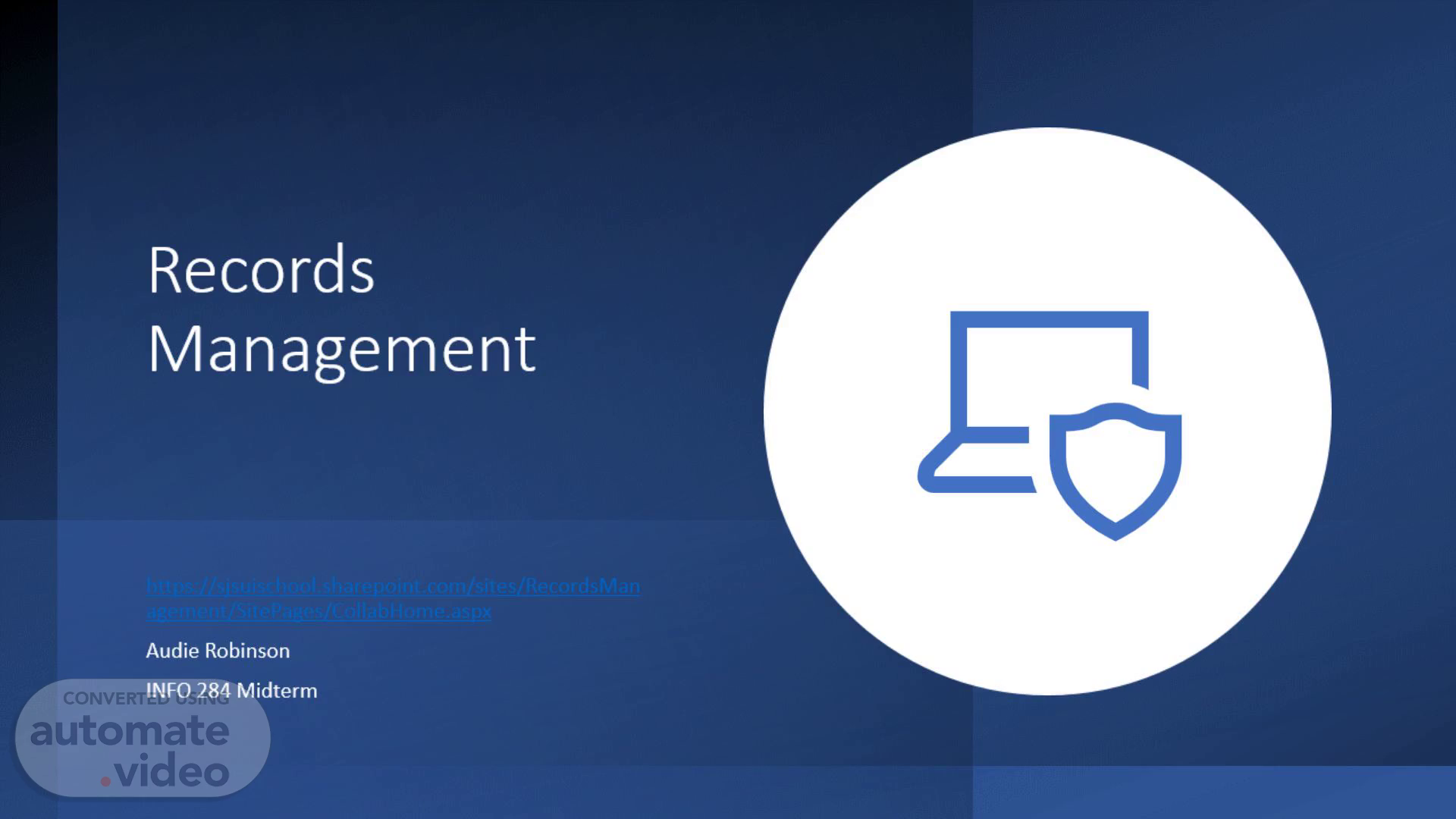Scene 1 (0s)
[Audio] Hello, and welcome to my presentation summarizing the completion of my SharePoint project for INFO 284: Seminar in Archival and Records Management. Over the past few weeks, I've been developing a SharePoint site to effectively manage records and archives. This project demonstrates my understanding of SharePoint as a content management platform and its potential for records management. I followed the course modules to build the site, starting with the basic setup and configuration in Module 2. This included establishing the site, customizing navigation, and adding essential components like document libraries and lists. The site now features core elements for managing records, such as retention settings, manually declared records, and a working records center. I also integrated surveys to streamline the management process and enhance overall functionality. In the following slides, I'll highlight key assignments and milestones, discuss significant accomplishments, and share what I learned along the way..
Scene 2 (1m 5s)
[Audio] This slide highlights essential elements I incorporated into the SharePoint site's homepage, showcasing the platform's versatility in managing content and records. I included a Newsfeed feature for users to post updates and announcements, fostering collaboration and engagement. I added Quicklinks for fast access to important resources: N-S-L-A (Nevada State Library, Archives & Public Records): Linking to nsla.nv.gov provides users with additional resources for library services and records management. State Records Center: A direct link for easy access to state-specific records policies and retrieval services. Local Government Records Management Resources: This link directs users to vital resources, offering guidance on retention schedules and best practices. The Photo Gallery stores and displays images related to organizational events, while the World Clock aids time zone coordination for teams in different regions. Task List: I included a Task List that organizes project assignments, deadlines, and responsibilities. This feature ensures that team members stay on track and are aware of their specific duties. These elements work together to create a well-organized homepage that facilitates efficient communication, navigation, and records management..
Scene 3 (2m 24s)
[Audio] This slide focuses on key pages and subsites that enhance the functionality of the SharePoint site for records management. A significant addition is the Directory Page, which provides a comprehensive list of key contacts within the records management program. This ensures clear communication across teams and helps users connect with the right people for specific records management issues. I also created a Subsite dedicated to assessing local government records needs. This subsite addresses unique challenges in local government records management and includes: Assessment tools for evaluating records management practices. Guidelines for developing retention schedules aligned with local government standards. Best practices for the storage, retrieval, and disposal of local government records. By building these pages and subsites, I've expanded the site's usability, allowing it to better serve both internal users and external stakeholders. These additions ensure the site remains organized and functional for all aspects of records management..
Scene 4 (3m 31s)
[Audio] This slide highlights two essential features: the Calendar and the Record Retention/Declaration functions, vital for managing records and timelines. The Calendar tracks important dates, such as records retention deadlines and key events within the records management program. This visibility helps users stay organized and proactive in their records management responsibilities. I implemented the Record Retention and Declaration functions to ensure compliance with records management policies. Records can be manually declared at any lifecycle stage, marking them for special handling according to established retention schedules. Retention labels automatically categorize records by retention periods, triggering actions such as archival or deletion once the period is reached. This ensures all records are managed according to policy, reducing compliance risks and unnecessary document storage..
Scene 5 (4m 26s)
[Audio] "his slide focuses on two critical components: the Image Library and the Document Libraries. I set up two document libraries for specific needs: State Records Directory: Contains key documents related to important contacts within the records program, providing a centralized reference point for contact details. 1160 Project Library: This space stores essential resources for team members, including guidelines and project timelines, fostering collaboration and keeping the project on track. The Image Library features photos of the State Records Center and archival items, providing valuable visual resources for documentation and training purposes. Both the document and image libraries enhance the records management system by providing organized spaces for key documents and visual materials..
Scene 6 (5m 16s)
[Audio] "his slide highlights the central Page for the records management program and the integrated Survey tool. The Survey feature gathers feedback from participants, especially on local government use of the Records Management Manual. It collects valuable information about challenges and areas needing guidance. This survey is essential for understanding local implementation of the manual and informs future updates to both the manual and the records management program. By actively seeking input, we ensure the program continues to meet the evolving needs of local government partners..
Scene 7 (5m 51s)
[Audio] I hope this presentation has provided valuable insights into the project and its key developments. This work is part of my midterm project for INFO 284, focusing on records management and the creation of a SharePoint site for my organization..
